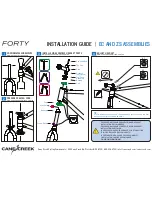
Align Brake Levers
The first step is to set up your brake levers. Start by loosening the clamp, and
then align them so that they match the angle of your arms when you’re riding.
Once the angle is set, tighten the clamp. If you have smaller hands and your
levers are hard to reach, you can set them closer by tightening the reach ad-
justment screw on most levers.
Remove & Inspect Brake Pads
Start by giving the cable some slack. Tighten the lever’s barrel adjuster in all
the way. Then pull the protective rubber back and disconnect the brake ca-
ble’s quick release mechanism.
Then remove the pads. V-brake pads have two sets of positioning washers on
each side of the brake arm. Be careful to watch how the washers are posi-
tioned so that you can re-install them correctly.
Inspect your pads. If they are worn past the indicator line, or have metal pok-
ing through the surface, you’ll need to replace them. If they look ok, use your
sandpaper to re-surface both pads.
Adjust Brake Arm Tension
Now check your brake arm tension. The brake arms should have good spring
tension, which makes them release when you let go of the brake lever. If
there isn’t much tension, you may have to increase it on both sides. Undo
both bolts one at a time, but don’t remove them completely.
You’ll notice a small piece of metal poking out the backside of the brake. This
is the spring, and it slides into one of three holes on your frame or fork. Most
brakes work fine in the middle hole. To increase your brake tension, move
the spring into the top hole. To decrease the brake tension, move the spring
into the bottom hole. Then tighten the mounting bolt.
Install & Align Brake Pads
Now re-install the brake pads, with the washers in the same order as they
were before. Align the brake pads so the pad face is flat against the rim. V-
brake pads are different from traditional pads in that they don’t require any
toe-in. Both the front and rear of the pad should contact the rim at the same
time. Because of this, v-brakes will sometimes squeak when applied. If
you’ve re-surfaced the pads and they are still noisy, you may have to try a
higher quality set of pads.
Take a look from the side to make sure the pad is in line with the rim’s brake
surface, and not touching the tire or hanging off the bottom of the rim.
BRAKE ADJUSTMENT
ASSEMBLEY
IT IS ALWAYS RECOMMENDED THAT BICYCLE IS
ASSEMBLED AND CHECKED BY A COMPETENT
BICYCLE MECHANIC
CAREFULLY UNPACK AND UNTIE HEADSTEM ASSY FROM
FRAME BEING CAFULL TO NOT STRAIN WIRING LOOM
INSERT HEADSTEM INTO FRONT FORK ASSEMBLY MAKING
SURE THE CUT MARK IN STEM IS NOT
VISABLE
AFTER ALIGNING HANDLE BAR
TIGHTEN 12MM NUT THROUGH SLOT
IN HEADSTEM COVER
DO NOT OVERTIGHTEN
ARRANGE WIRING LOOM AND FAS-
TEN TO TRIKE WITH CABLE TIES SUP-
PLIED ASM PER PICTURE MAKING
SURE THE CABLE DOSNT CATCH ON
MUDGAURD AND THAT WHEEL CAN
BE TURNED BOTH WAYS WITHOUT
STRAINING WIRING LOOM.
CUT EXCESS OFF TIE.
FOR TRANSPORT THE TAILLAMP ASSEMLY IS TIED TO THE
FRAME NEAR LEFT WHEEL.UNDO THE TIES AND BOLT THE
BRACKET TO REAR OF TRIKE
USING THE REFLECTOR
MOUNTING BOLTS. THE
CROSSBAR GOES TO THE IN-
SIDE OF THE BRACKETS
























